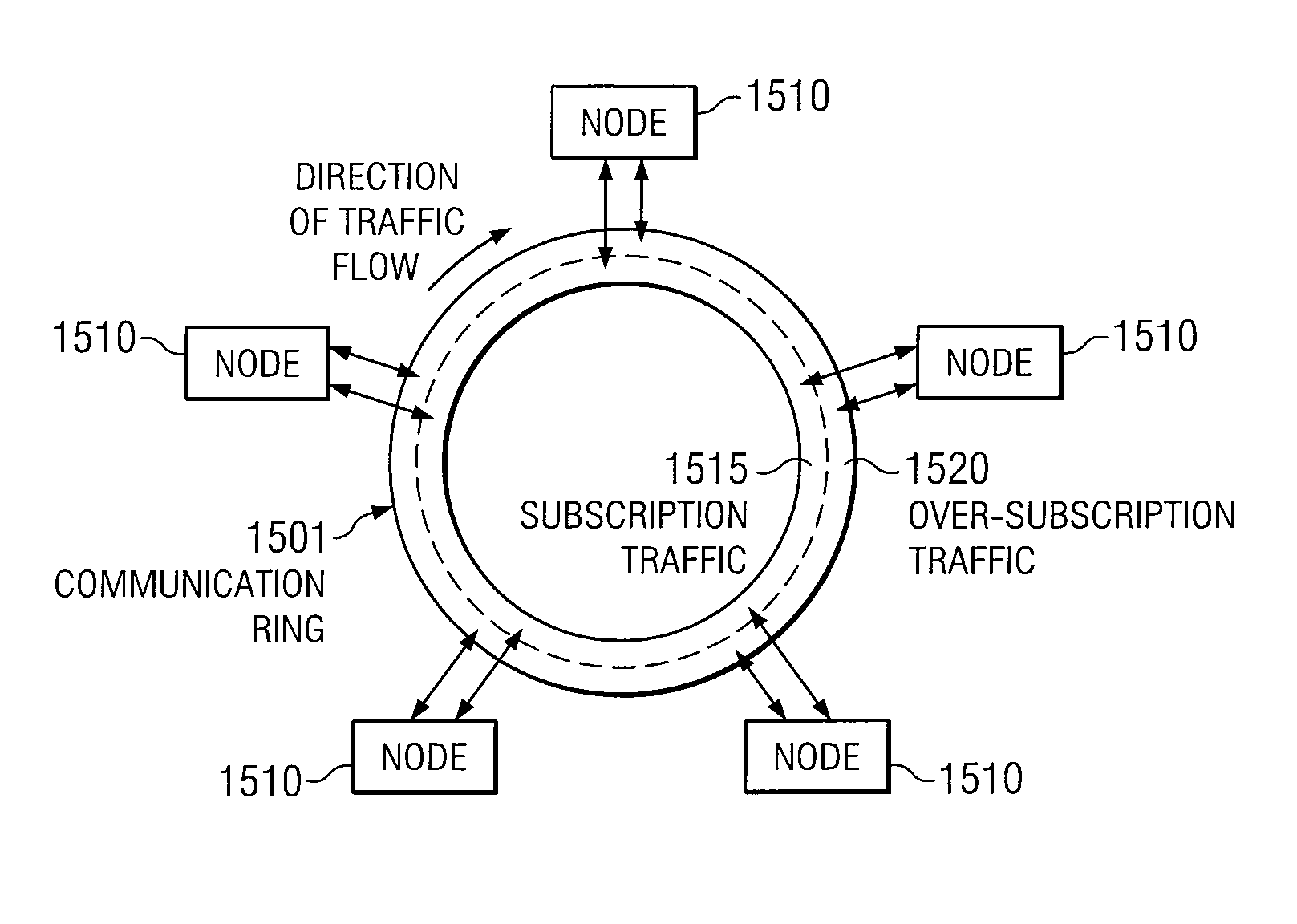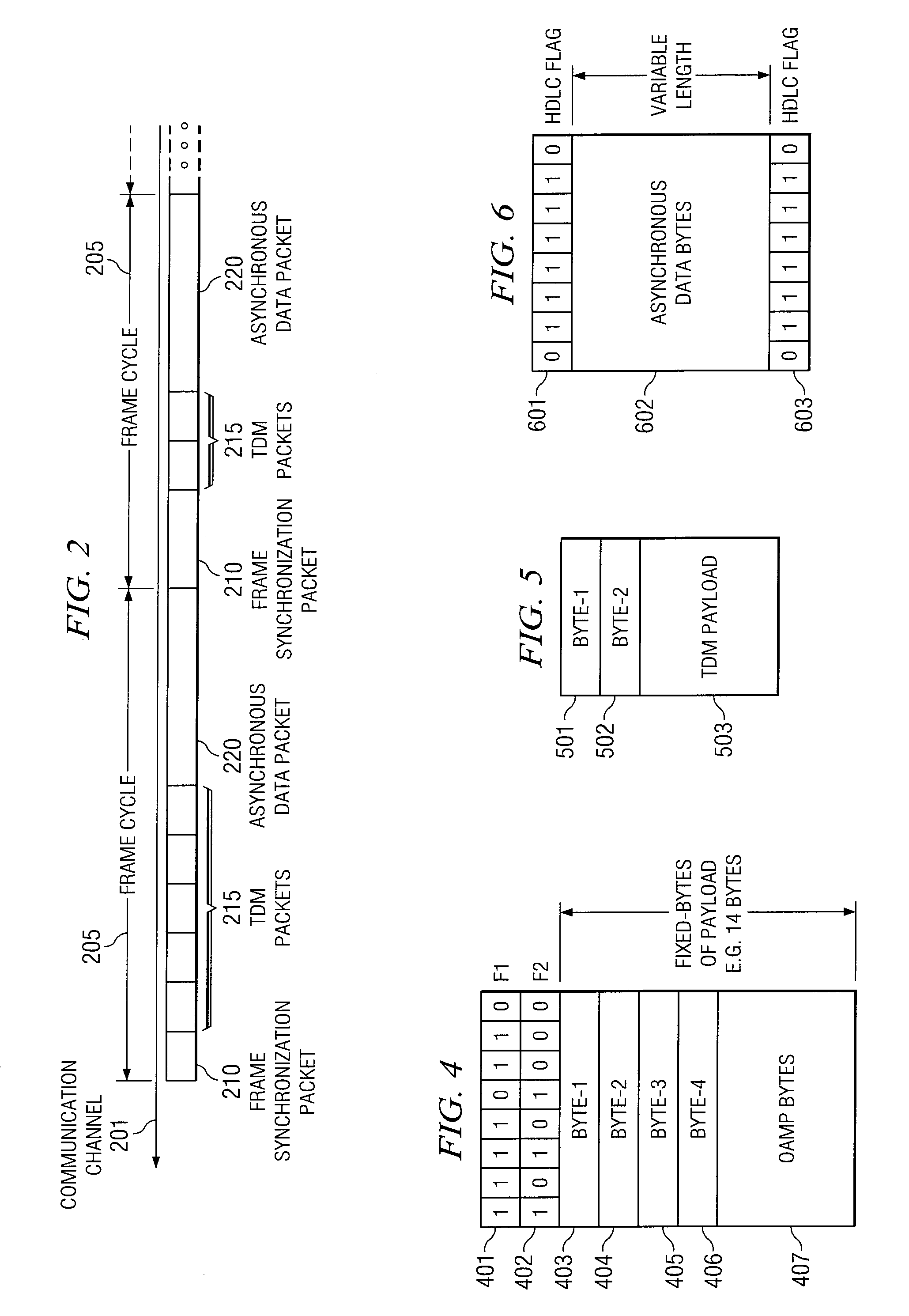[0007]An object of the present invention is to efficiently transport synchronous data with limited jitter over a
communication channel while making the remaining available bandwidth of the channel available for the transport of asynchronous data. A further object of the present invention is to provide
congestion management for ring-based communication systems. Advantages of the present invention are that jitter is limited, multiplexing and demultiplexing of synchronous data is simplified, and otherwise unused bandwidth is made available for the transport of asynchronous data. A further
advantage of the present invention is that high-priority traffic being transported on ring-based communication channels may be assigned sufficient bandwidth for transmission on the ring even during periods of congestion, while other traffic is efficiently provided with ring bandwidth as it becomes available.
[0008]Some embodiments of the present invention inject a timing
synchronization signal into a
communication channel to facilitate the minimization of jitter and the transportation of asynchronous data, and to simplify the multiplexing and demultiplexing of synchronous data. The timing
synchronization signal is injected into the
data stream on the communication channel at
fixed time intervals and is used to regulate the timing of all synchronous data, including Time Division
Multiplex data (“TDM”), and asynchronous data transportation on the channel. In some embodiments, the timing
synchronization signal is carried in a fixed-length frame synch packet with a unique frame code that is transported unscrambled in order to reduce the time needed to re-synchronize to the timing synchronization
signal.
[0009]In some embodiments of the present invention, the synchronous data, including TDM data, is transported in a synchronous data packet with the
payload length of the synchronous data packet being indicated by a length indication
byte in the header of the packet. In some embodiments, synchronous data packets from a particular synchronous input channel will be injected into the communication channel at a particular, fixed, predetermined time in relation to the timing packet. This predetermined time is assigned to the synchronous input channel during
service provisioning time and may be adjusted as additional synchronous input channels are provisioned.
[0010]In some embodiments of the present invention, the bandwidth on the communication channel that is not reserved for synchronous data and the timing synchronization
signal is provisioned as a single sub-channel for asynchronous (including
High Level Data Link Control (HDLC)) data packets. The incoming asynchronous
data stream is packetized and inserted into the sub-channel at those time intervals that are not reserved for synchronous data or the timing synchronization
signal.
[0011]Some embodiments of the present invention, related to communication rings, assign a baseline amount of bandwidth (the “subscription” bandwidth) and an Acceptable Over-Subscription Bandwidth to each communication node on a communication ring. The maximum amount of ring bandwidth that a node is permitted to use at any particular time, in addition to the node's baseline subscription bandwidth, is the node's Access Bandwidth. The actual ring bandwidth available to a node at any particular time, in addition to the node's baseline subscription bandwidth, is the node's actual Over-Subscription Bandwidth. For each node, if the amount of over-subscription bandwidth available on the ring is less than the Acceptable Over-Subscription Bandwidth and the node's over-subscription traffic that is ready to be sent to the ring requires more than the node's actual Over-Subscription Bandwidth, then an access congestion indication will be sent to the rest of the nodes on the ring.
[0012]Further, a Maximum Over-Subscription bandwidth is also assigned to each communication node. Each node will not send more over-subscription traffic than the Maximum Over-Subscription Bandwidth. The Maximum Over-Subscription Bandwidth of particular nodes is set at the
service provisioning time, as is known in the art, based on factors including the traffic types and number of customers, thus providing access fairness for each node and minimizing the effect of location-dependent advantages.
 Login to View More
Login to View More  Login to View More
Login to View More 


